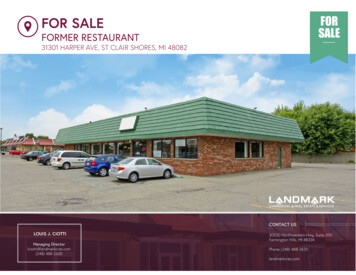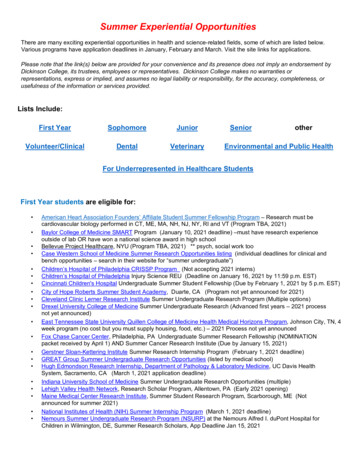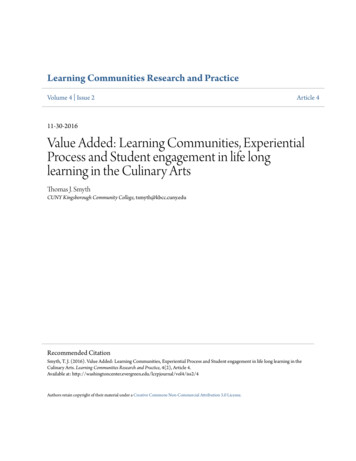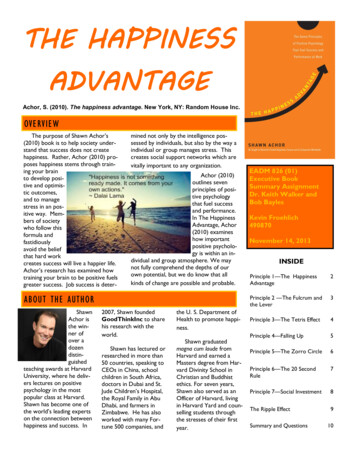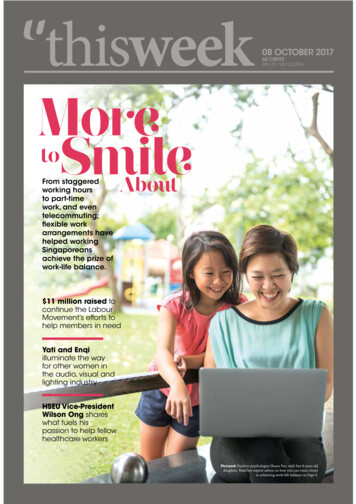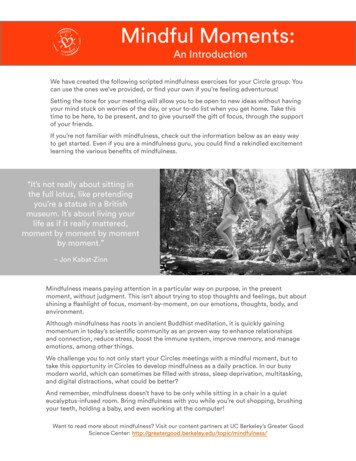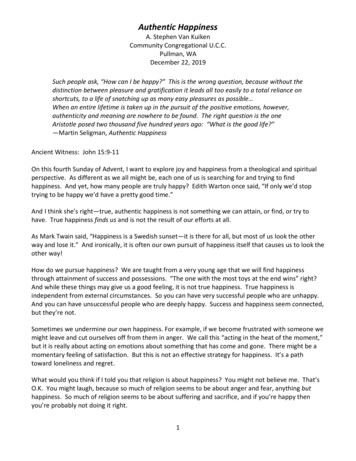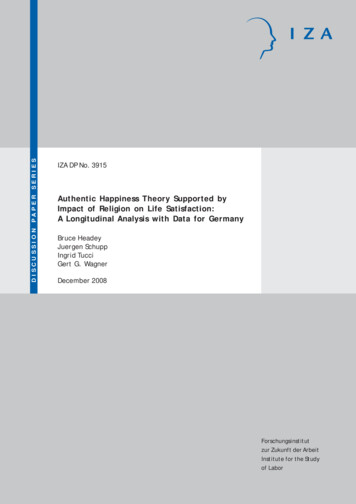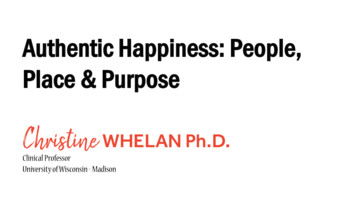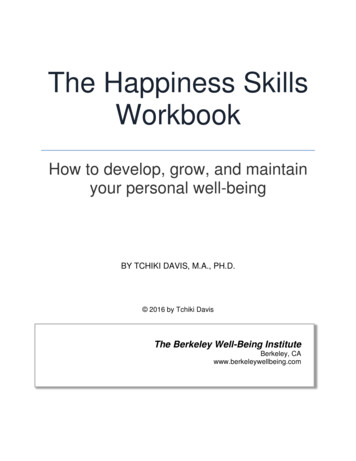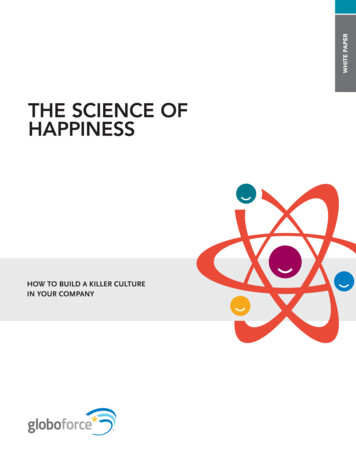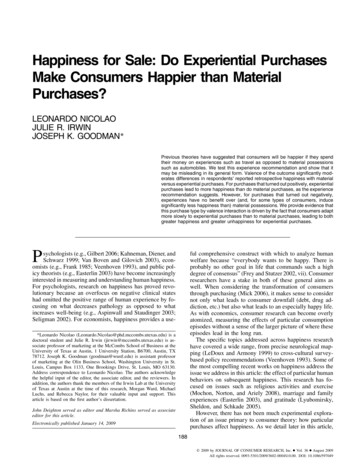
Transcription
Happiness for Sale: Do Experiential PurchasesMake Consumers Happier than MaterialPurchases?LEONARDO NICOLAOJULIE R. IRWINJOSEPH K. GOODMAN*Previous theories have suggested that consumers will be happier if they spendtheir money on experiences such as travel as opposed to material possessionssuch as automobiles. We test this experience recommendation and show that itmay be misleading in its general form. Valence of the outcome significantly moderates differences in respondents’ reported retrospective happiness with materialversus experiential purchases. For purchases that turned out positively, experientialpurchases lead to more happiness than do material purchases, as the experiencerecommendation suggests. However, for purchases that turned out negatively,experiences have no benefit over (and, for some types of consumers, inducesignificantly less happiness than) material possessions. We provide evidence thatthis purchase type by valence interaction is driven by the fact that consumers adaptmore slowly to experiential purchases than to material purchases, leading to bothgreater happiness and greater unhappiness for experiential purchases.Psychologists (e.g., Gilbert 2006; Kahneman, Diener, andSchwarz 1999; Van Boven and Gilovich 2003), economists (e.g., Frank 1985; Veenhoven 1993), and public policy theorists (e.g., Easterlin 2003) have become increasinglyinterested in measuring and understanding human happiness.For psychologists, research on happiness has proved revolutionary because an overfocus on negative clinical stateshad omitted the positive range of human experience by focusing on what decreases pathology as opposed to whatincreases well-being (e.g., Aspinwall and Staudinger 2003;Seligman 2002). For economists, happiness provides a use-ful comprehensive construct with which to analyze humanwelfare because “everybody wants to be happy. There isprobably no other goal in life that commands such a highdegree of consensus” (Frey and Stutzer 2002, vii). Consumerresearchers have a stake in both of these general aims aswell. When considering the transformation of consumersthrough purchasing (Mick 2006), it makes sense to considernot only what leads to consumer downfall (debt, drug addiction, etc.) but also what leads to an especially happy life.As with economics, consumer research can become overlyatomized, measuring the effects of particular consumptionepisodes without a sense of the larger picture of where theseepisodes lead in the long run.The specific topics addressed across happiness researchhave covered a wide range, from precise neurological mapping (LeDoux and Armony 1999) to cross-cultural surveybased policy recommendations (Veenhoven 1993). Some ofthe most compelling recent works on happiness address theissue we address in this article: the effect of particular humanbehaviors on subsequent happiness. This research has focused on issues such as religious activities and exercise(Mochon, Norton, and Ariely 2008), marriage and familyexperiences (Easterlin 2003), and gratitude (Lyubomirsky,Sheldon, and Schkade 2005).However, there has not been much experimental exploration of an issue primary to consumer theory: how particularpurchases affect happiness. As we detail later in this article,*Leonardo Nicolao (Leonardo.Nicolao@phd.mccombs.utexas.edu) is adoctoral student and Julie R. Irwin (jirwin@mccombs.utexas.edu) is associate professor of marketing at the McCombs School of Business at theUniversity of Texas at Austin, 1 University Station, B6700, Austin, TX78712. Joseph K. Goodman (goodman@wustl.edu) is assistant professorof marketing at the Olin Business School, Washington University in St.Louis, Campus Box 1133, One Brookings Drive, St. Louis, MO 63130.Address correspondence to Leonardo Nicolao. The authors acknowledgethe helpful input of the editor, the associate editor, and the reviewers. Inaddition, the authors thank the members of the Irwin Lab at the Universityof Texas at Austin at the time of this research, Morgan Ward, MichaelLuchs, and Rebecca Naylor, for their valuable input and support. Thisarticle is based on the first author’s dissertation.John Deighton served as editor and Marsha Richins served as associateeditor for this article.Electronically published January 14, 2009188䉷 2009 by JOURNAL OF CONSUMER RESEARCH, Inc. Vol. 36 August 2009All rights reserved. 0093-5301/2009/3602-0004 10.00. DOI: 10.1086/597049
HAPPINESS FOR SALEthis gap in the literature may be due to a surprising agreementamong theorists on this issue. Perhaps the theory has provedso convincing that experimentalists saw no need to test it.Dating as early as Hume (1737/1975) and through Scitovsky(1976) and Frank (1985), the sentiment has been that individuals will be happier if they spend their money on experiences (e.g., theater, concerts, and vacations) as opposed tomaterial purchases (e.g., fancy cars, bigger houses, and gadgets). We term this the experience recommendation.There is only one published empirical test of this experience recommendation. Van Boven and Gilovich (2003),using a number of clever experiments, found that their respondents did derive more happiness from positive experiential purchases when compared to positive material purchases. Our article is a long overdue experimental treatmentof this issue.In three experiments, we affirm Van Boven and Gilovich’s(2003) finding, but we show that their results are limited topositive purchases. For negative purchases, experienceshave no advantage over material goods, and sometimes material purchases even induce more happiness than do experiences, the opposite of the experience recommendation.We provide evidence that the experiences versus materialgoods distinction (as opposed to some other correlated variables) is underlying our results. For instance, a well-testedmaterialism scale moderates the findings in both our firstand second experiments.Moreover, in the first experimental test of hedonic adaptation rates across types of purchases, we show that individuals adapt slower to experiential purchases when compared to material purchases. This differential in adaptationrates for experiential and material purchases is the underlying mechanism for our effects. Because individuals adaptmore slowly to experiential purchases, adaptation leads toboth lower (for negative purchases) and higher (for positivepurchases) levels of retrospective happiness for experientialversus material purchases.THEORETICAL BACKGROUNDWhat Is Happiness, and How Does PurchasingAffect It?We use the terms happiness and subjective well-being(Diener 1984) interchangeably. Other researchers (e.g.,Frank 1999; Seligman 2002) have established that these termsare strongly interrelated and that ratings of happiness correlatehighly with other measures of both psychological and physiological well-being (e.g., Sutton and Davidson 1997). Although measures of subjective well-being sometimes includeother affective and cognitive components (e.g., satisfactionwith life; Pavot and Diener 1993), happiness explains mostof the variance in the subjective well-being construct (Compton et al. 1996).Happiness is measurable, predictable, and comparableacross contexts (Diener 1984; Diener et al. 1999; Gilbert2006; Layard 2005). We follow previous researchers in characterizing happiness as an overall sense that life is good (My-189ers 1992), that life contains many positive situations and emotions (Ahuvia 2008; Lyubomirsky, King, and Diener 2005).Researchers typically measure happiness by asking peoplehow happy they are (see Kahneman et al. 1999 for manyexamples) or how happy they are with a particular situation(Raghunathan and Irwin 2001) using multi-item scales.Scitovsky (1976) suggested some years ago that purchasingmay have a negative impact on happiness because consumersoften buy “joyless” material possessions such as houses andcars, resulting in comfort but not pleasure. Likewise, Easterlin(2003) has proposed that investment in “pecuniary” marketobjects has no effect on happiness. In his essay “How Notto Buy Happiness” (2004), Robert Frank echoes these sentiments by recommending against the accumulation of “conspicuous goods” in the pursuit of happiness. These recommendations lead us to wonder, by encouraging people to buymore things, are marketers encouraging them toward a lesshappy life?Most of the writers who discuss the negatives of materialgoods nevertheless do suggest that some types of purchasesmay increase happiness. Scitovsky (1976) argues for culturalexperiences such as vacations and concerts to provide pleasure. Thought exercises based on adaptation studies arguethat consumers might be happier trading their materialwealth (e.g., a percentage of the square footage of theirhouse) for a more pleasant day-to-day lifestyle (e.g., a morepleasant commute) and more enjoyable experiences throughout the year (e.g., more vacation time; Frank 1999). In hisbook, The Happiness Hypothesis (2006, 101), JonathanHaidt suggests that people should, “accumulate less, and‘consume’ more . . . vacations, and other enjoyable activities.” In other words, there is a suggestion that purchasesof material goods (e.g., cars, houses, furniture) should, overall, lead to less happiness compared to purchases of experiential goods (e.g., vacations, concerts, sporting events).We call this suggestion “the experience recommendation.”Besides appearing in the writings outlined above, this recommendation has been established empirically (Van Bovenand Gilovich 2003) and can be traced back to Hume (1737/1975, 283), who extols experiences (e.g., theater) as superiorto “the acquisition of worthless toys and gewgaws.”What distinguishes material from experiential purchases?Material purchases are tangible; they may be taken fromplace to place, they last beyond a couple of days, and theytake up physical space. Stereos, cars, and houses are examples of material goods. Experiential purchases are nottangible. Rather, the purchase entitles the consumer to anevent that is finite in time. Movies, amusement parks, andrestaurant dinners are examples of experiential purchases.The material/experiential distinction is a continuum. Forsome purchases, for some consumers, locating particularpurchases on the continuum may be difficult. However, thefindings of Van Boven and Gilovich (2003) and the intuitions of many others (e.g., Easterlin 1995; Pine and Gilmore1999; Scitovsky 1976) suggest that this distinction existsand that consumers can easily discriminate between the twotypes of purchases. Future research will likely uncover ad-
190ditional subtleties relevant to these two categories of purchases (e.g., performance characteristics [Deighton 1992],vividness, degree of social interaction, memory distortions),but for now we concentrate on this basic distinction andterminology. Doing so allows us to speak to the experiencerecommendation and to link our work with previous workin the area.Happiness, Consumption, and the HedonicTreadmillIn addition to documenting and testing the experiencerecommendation, we propose and test an underlying mechanism for our findings. We suspect that purchase type affectsthe “hedonic treadmill” (Brickman and Campbell 1971; Raghunathan and Irwin 2001), the adaptation mechanism thatintegrates positive purchases into the decision makers’ reference point, shifting the purchase into the status quo insteadof a gain (Kahneman, Knetsch, and Thaler 1991; Samuelsonand Zeckhauser 1988). Experiences might be less susceptible to this treadmill; people continue to enjoy past pleasantexperiences via memories (Frederick and Loewenstein 1999;Van Boven and Gilovich 2003), and experiences may havemore of a lasting impact on one’s life (Frank 2004; Scitovsky 1976).The hedonic treadmill is driven by hedonic adaptation(Frederick and Loewenstein 1999), which refers to the lessening of a hedonic response over time. Better things becomeless good over time, and worse things become better. Notethat there are two general classes of work on hedonic adaptation (see Frederick and Loewenstein [1999] for manyexamples of each): measuring adaptation to a continuallyrepeating stimulus (e.g., traffic noise [Weinstein 1982] orincarceration [Wormith 1984]) and measuring adaptation toa stimulus that occurs once (e.g., buying a luxury good[Frank 1999]). Our work focuses on the latter, which is morerelevant to most marketing contexts, matches the discussionsof adaptation in most of the happiness literature, and fitsmore closely with the experience recommendation.Others have suggested that hedonic adaptation rates mayvary by type of stimuli. For instance, Van Boven (2005)surmises that people may tend to adapt faster to materialpurchases because (positive) experiential purchases remainopen to positive reinterpretation (Mitchell et al. 1997). Asa consequence, memory keeps the experiences from declining in happiness over time. Likewise, in their review ofadaptation rates, Frederick and Loewenstein (1999) find thatpeople show very little adaptation both to certain positiveexperiences such as plastic surgery and certain negative experiences such as loss of a loved one, whereas adaptationto material gains such as a particular increase in income isquite rapid. In a chapter of his book Luxury Fever entitled“Gains That Endure,” Frank (1999, 88) considers whethersome purchases might provide slower adaptation than luxurygoods, which, he argues, place consumers on an endlesshedonic treadmill. He focuses on experiences such as vacations, saying: “Provided they are of sufficient duration,JOURNAL OF CONSUMER RESEARCHvacations have been shown to have restorative effects thatpersist long after people return to work.” The one-time purchase of a vacation may lead to slower adaptation over time,and thus more happiness, than spending a similar amounton a luxury object.We agree with this supposition, and we expand it to suggest that, in general, people adapt to experiences, on average,more slowly than to material purchases. Note that we applythis proposition both to negative and positive purchases:hedonic adaptation would result in a positive experienceinducing more happiness but a negative experience inducingless happiness than the comparable material purchase withthe same initial happiness level. In our third experiment, wedirectly test hedonic adaptation rates over time, by purchasetype and valence, and we show that hedonic adaptation underlies our primary finding. In other words, we propose (andshow) that hedonic adaptation, by reducing the unhappinesswith negative purchases as well as the happiness with positivepurchases at different rates across purchase type, results inconcomitant differences in retrospective happiness. Furthermore, we show that this adaptation happens quite quickly,often in a matter of minutes. Our work is the first (that weknow of) to test for happiness with both positive and negativeexperiential/material purchases and also the first to explicitlytest purchase-type adaptation differences in time.Thus, we experimentally address three components of theexperience recommendation: (1) whether/when the recommendation is appropriate, (2) whether the appropriateness ofthe recommendation depends on consumer characteristicssuch as materialism, and (3) the mechanism underlying theappropriateness of the experience recommendation.EXPERIMENT 1This experiment tested whether outcome valence moderates the effect of purchase type on happiness. Respondentsfirst recalled a purchase (positive or negative, and materialor experiential) and then indicated their retrospective happiness with the purchase. We expected the experience recommendation to hold for positive purchases but not for negative purchases.In addition, we measured respondents’ level of materialism, which is defined as attachment to material possessions, including an enmeshed relationship between the ownership of objects and one’s sense of self (Richins andDawson 1992, 308). Although researchers have addressedthe societal and personal impact of materialism (many ofthem arguing that it has a negative influence [e.g., Burroughsand Rindfleisch 2002; Kasser 2002]), for our purposes themeasure of materialism allows us to affirm our material/experiential continuum by isolating consumers for whommaterial purchases are especially important versus especiallyunimportant. As materialism increases, the adaptation ratesfor material purchases (both positive and negative) shoulddecrease; material purchases should resonate longer for materialistic consumers, affecting happiness more. Thus, weexpected a three-way interaction between materialism, va-
HAPPINESS FOR SALElence, and purchase type: the valence by purchase type interaction should grow stronger as materialism decreases.MethodA total of 211 undergraduates from various colleges at theUniversity of Texas at Austin participated in the experimentin exchange for extra credit. We asked respondents to recalla personal purchase. There were four between-subjects conditions: the purchases were either experiential or material, andthey were either positive or negative. For the material purchases, we asked respondents the following:Please describe a time when you spent about 300 on anobject. You kept the object for some time and may even stillhave it. It was an object you could touch with your hand.You bought the object to increase your happiness.For the experiential purchases, we asked the following:Please describe a time when you spent about 300 on anexperience. In other words you did not end up with anythingtangible (anything you could hold in your hand) at the endof the experience except for your memories. You bought theexperience to increase your happiness.We adapted these instructions from Van Boven and Gilovich (2003), with more neutral wording to accommodateour positive and negative conditions (Van Boven and Gilovich solicited memories of purchases around 50, and inan unreported test of our two-way interaction we replicatedour results with this amount as well). The outcome valencewas manipulated in the last sentence of the instructions:“And, it turned out well and you did enjoy the purchase”versus “Unfortunately, it did not turn out well and you didnot enjoy the purchase.” For the material purchases, weinstructed participants that the purchases could not be soldor given away, so that any confound with potential resalewas eliminated.Next, respondents rated their purchase on three 7-pointhappiness scales adapted from Van Boven and Gilovich(2003): “When you think about this purchase, how happydoes it make you?” (Not Happy–Moderately Happy–VeryHappy), “How much does this purchase contribute to yourhappiness in life?” (Not at All–Moderately–Very Much), “Towhat extent do you think the money spent on this purchasewould have been better spent on something else—some othertype of purchase that would have made you happier?” (Notat All–Moderately–Very Much). These measures formed onescale (a p .86). (In all three studies the first two questionswere highly correlated [r 1 .9], and using only the first measure resulted in the same results as using all three.) In addition,we asked respondents how much they spent and how manymonths ago they made the purchase. After the happiness task,participants answered the nine-item version of “The MaterialValues Scale” (MVS; Richins 2004), which we combined intoone measure (a p .84).191Results and DiscussionTwenty-one participants reported the wrong purchase valence and were dropped from the analyses. These participants reported positive purchases when asked for negativepurchases and vice versa. The likelihood of not followingthe instructions was not influenced by the conditions of thisexperiment (x 2 ! 1.5, NS).Overall, we did not find support for the experience recommendation: there was not a reliable relationship betweenthe material versus experiential variable and reported happiness with the purchases (F(1, 185) p 1.95, NS). As weexpected, the effect of purchase typ
Jan 14, 2009 · Valence of the outcome significantly mod- . (Leonardo.Nicolao@phd.mccombs.utexas.edu) is a doctoral student and Julie R. Irwin (jirwin@mccombs.utexas.edu) is as- . addition, the authors thank the members of the Irwin Lab at the University of Texas at Austin at the time of this research, Morgan Ward, Michael
